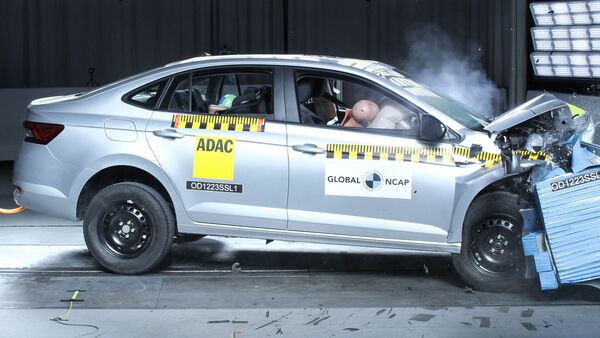Buying a car with a high NCAP rating is not enough. Key points to understand
India leads the world in many metrics but one of them is very unfortunate. The number of lives lost and the number of people who get crippled physically in road accidents every year is massive. Each year, India witnesses around 1.5 lakh people die in road crashes and several lahks more face severe injuries leaving many handicapped for life. A study by FICCI-EY revealed that India accounts for 11 per cent of global deaths in road crashes despite the country having just one per cent of the global vehicle fleet.
 NCAP testing and rating have their own limitations and don't always replicate real-world crash scenarios.
NCAP testing and rating have their own limitations and don't always replicate real-world crash scenarios.
While the loss of lives and critical injuries cause irreparable loss for millions of people and their families every year, its economic impact is highly significant. World Bank has reported that India loses three to five per cent of overall GDP every year due to road accidents. These numbers are shocking and raise many questions. The launch of Bharat NCAP, India's indigenous car crash safety testing and evaluation program[1] has again fuelled talks about car safety.
Also Read : Bharat NCAP vs Global NCAP: Similarities and differences explained[2]
With the advent of new advanced technologies, modern cars have become safer and more reliable. Road infrastructures have been improving across the country ranging from metro cities to lower-tier cities and highways. The government has been introducing tightening laws for the automakers to make safer cars, while the traffic rules for drivers and riders also are increasingly becoming stringent. Despite such moves, why the accidents are taking place leading to life loss and critical injuries to many? The answer probably lies in the behaviour of drivers and pedestrians as well as in several other factors including road conditions.
Here comes the question. Is getting a car with a high NCAP rating enough for your safety? The answer to that question is no. Just buying a car with a high NCAP rating doesn't guarantee your safety in crashes. This is because NCAP ratings also have limitations. NCAP ratings miss out on mentioning some crucial points. Let's take a look at that to understand why buying a higher NCAP-rated car is not everything.
Why NCAP crash tests don't promise ultimate safety
NCAP crash tests and ratings don't promise ultimate safety for a car and its occupants because these test protocols and rating systems have their own limitations. Here are five key points to make you understand that.
NCAP tests don't cover all real-world scenarios
The NCAP crash tests' biggest limitation is that the tests are performed in a controlled lab environment, not in the real world. Hence, they don't imitate all the real-world scenarios a vehicle may face. In short, the NCAP tests are done in a much simpler way where multiple vehicles and other factors are not involved, while a real-world crash can involve multiple vehicles across sizes running at variable speeds., making situations more complex.
NCAP tests take place at simulated speeds
NCAPs test the vehicles at a pre-decided speed, which is usually between 30 kmph and 64 kmph for side impact and frontal impact, respectively. In the real world, in many cases, the vehicles involved in accidents are found running at over 100 kmph speed prior to the crash. Hence, higher speed means the more severe the crash and its impact. Also, it has to be noted that the relation between speed and severity of injury is not linear.
Crash compatibility between colliding vehicles
One of the most important factors in a crash is the crash compatibility which decides the extent of impact on the colliding vehicles and their occupants. NCAPs crash test simulating collision between two cars having similar weight and height, which may not replicate in a real-world crash scenario. Ratings do not apply to incompatible crash scenarios such as a car colliding with a truck. This comes as a huge limitation for NCAP ratings. You can see the crash incompatibility on numerous counts on Indian roads, making the NCAP ratings void in such cases.
Child safety is often ignored by car owners
The NCAPs crash test the vehicles with the child dummy seated in a secure child seat at the rear of the car. However, there is no reason to believe that in the real world, a car owner will use the child seat for his or her kid, and the child will not sit on somebody's lap. Hence, the child safety rating for any NCAP crash-tested and rated vehicle may not be valid in case of a real-world car crash.
Driving behaviour matters
Driving behaviour plays a major role in determining the safety of a vehicle and its occupants. Carelessness, overspeeding, rash driving or overconfidence often play a key role in road accidents. Driving a five-star NCAP-rated car recklessly doesn't promise safety at all to the vehicle and its occupants. In fact, in the case of driving recklessly and at high speed, no safety technology or even the highest safety rating can't guarantee to save the driver and other occupants of the vehicle. Besides that, not wearing seatbelts, and reckless driving by fellow drivers are among other factors in determining the safety of a vehicle's occupants.
First Published Date: 24 Aug 2023, 14:44 PM IST
References
- ^ The launch of Bharat NCAP, India's indigenous car crash safety testing and evaluation program (auto.hindustantimes.com)
- ^ Bharat NCAP vs Global NCAP: Similarities and differences explained (auto.hindustantimes.com)